T Murrali
The Nissan vision – Dream, Access and Trust, has been kept in mind while engineering the Datsun GO. The company has built an automobile by not merely changing the external looks but by bringing in some unique technologies, which were earlier confined to only their premium cars. The final product would impress and attract customers in totality – design, looks and performance. Price of under Rs four lakh coupled together with significant levels of innovation will be the key differentiator in this segment that hitherto offered customers limited choice.
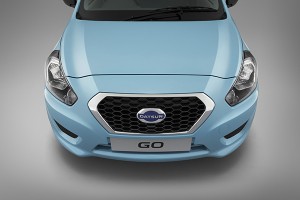 The car is designed to target 50 percent of the total industry volume in India, which is expected to double in 2016 from the level in 2010. Since Nissan had no presence in the sub-Rs four lakh segment, the company structured the new car to draw high-growth market customers aspiring for new and specific products and services. Eventually it boiled down to first time buyers wanting good mobility combined with enhanced social status – a car that would be a symbol of recognition for both family and society. The GO was, thus, based on three major objectives –it should be a modern entry level family car with good fuel efficiency and at accessible price. Breakthrough technology would be used to make the car ‘clear and robust’ whilst also creating a vivid and strong surface image.
The car is designed to target 50 percent of the total industry volume in India, which is expected to double in 2016 from the level in 2010. Since Nissan had no presence in the sub-Rs four lakh segment, the company structured the new car to draw high-growth market customers aspiring for new and specific products and services. Eventually it boiled down to first time buyers wanting good mobility combined with enhanced social status – a car that would be a symbol of recognition for both family and society. The GO was, thus, based on three major objectives –it should be a modern entry level family car with good fuel efficiency and at accessible price. Breakthrough technology would be used to make the car ‘clear and robust’ whilst also creating a vivid and strong surface image.
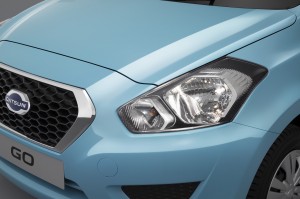 As far as styling goes, the crease flowing from the bonnet confluence at the diamond shaped grille gells well with the headlamps, giving the car a distinct trendy modern look. The curves encompassing the logo in the bonnet is replicated on the sides in A and C pillars. The headlamps, designed by India Japan Limited (IJL), are exclusive for this segment as it combines the ‘follow me’ option to help the driver when exiting the car during night-time. IJL president B S Sivaram says the comapny could achieve styling of headlamp while meeting the target cost by eliminating the bezel in the headlamp and by adding dummy in the reflector and painting in the housing. In order to increase the milage of the vehicle, the weight of the headlamp was reduced considerably though the lamp size is bigger. Instead of electrical headlamp levelling actuator, mehanical levelling actuator was offered, which played a major role in cost reduction of headlamp system, he adds.
As far as styling goes, the crease flowing from the bonnet confluence at the diamond shaped grille gells well with the headlamps, giving the car a distinct trendy modern look. The curves encompassing the logo in the bonnet is replicated on the sides in A and C pillars. The headlamps, designed by India Japan Limited (IJL), are exclusive for this segment as it combines the ‘follow me’ option to help the driver when exiting the car during night-time. IJL president B S Sivaram says the comapny could achieve styling of headlamp while meeting the target cost by eliminating the bezel in the headlamp and by adding dummy in the reflector and painting in the housing. In order to increase the milage of the vehicle, the weight of the headlamp was reduced considerably though the lamp size is bigger. Instead of electrical headlamp levelling actuator, mehanical levelling actuator was offered, which played a major role in cost reduction of headlamp system, he adds.
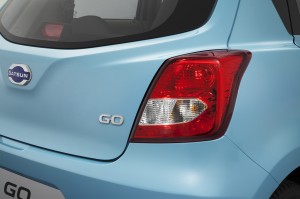 An intelligent wiping system, supplied by Mitsuba, automatically selects appropriate wiper interval as vehicle speed changes. The GO has a wheelbase of 2,450 mm with overall length 3,785 mm, height 1,485 mm, width 1,635 mm and a ground clearance of 170 mm. The height of the car helps in better driving position as the visibility to the driver is improved – perhaps closer to a compact SUV. The exterior is not ably supported by the tyre size – 155 / 70R13. A major missing convenience is the independent lock for the tailgate; it can only be opened by releasing the lever near the driver seat.
An intelligent wiping system, supplied by Mitsuba, automatically selects appropriate wiper interval as vehicle speed changes. The GO has a wheelbase of 2,450 mm with overall length 3,785 mm, height 1,485 mm, width 1,635 mm and a ground clearance of 170 mm. The height of the car helps in better driving position as the visibility to the driver is improved – perhaps closer to a compact SUV. The exterior is not ably supported by the tyre size – 155 / 70R13. A major missing convenience is the independent lock for the tailgate; it can only be opened by releasing the lever near the driver seat.
The creases and curves in the bonnet are reproduced in the cockpit and steering wheel. While the cockpit is split into three distinct zones featuring leather feel grain patterns and contrasting colours, the plastics and three-spoke steering are basic, as it is for any vehicle in this segment. The mobile docking station with USB charging is a unique feature, which can connect external devices including smart phones and digital gadgets to make it a full-fledged audio system.
 Dual colouring in the speedometer, the combination meter incorporating a digital tachometer, and gear shift guide are noticeable. The company claims that use of the gear shift guide will help reduce fuel consumption. The gear shift lever and parking brake handle mounted in the centre console is a signature design for the Datsun GO. Removing these controls from the floor enables easy ingress and egress to both driver and co-passengers from either side. This is a welcome option as it facilitates the driver’s exit from the passenger side if there is no access on his side; this is increasingly a necessity in most cities today. It also helps connect the front seats, storage space for a small bag or camera.
Dual colouring in the speedometer, the combination meter incorporating a digital tachometer, and gear shift guide are noticeable. The company claims that use of the gear shift guide will help reduce fuel consumption. The gear shift lever and parking brake handle mounted in the centre console is a signature design for the Datsun GO. Removing these controls from the floor enables easy ingress and egress to both driver and co-passengers from either side. This is a welcome option as it facilitates the driver’s exit from the passenger side if there is no access on his side; this is increasingly a necessity in most cities today. It also helps connect the front seats, storage space for a small bag or camera.
 The GO has a longer effective cabin, the feel enhanced by slimmer seats. The seat, developed by NKF India Automotive Seating, a tripartite joint venture between the seating division of NSK springs, Krishna Maruti and Faurecia, adds to optimal comfort. Kazusuki Yamaguchi, chief vehicle engineer, Datsun says, “The bending movements that create stress are canceled by the spinal-shaped backrest.” Typically, the bending movement in the spine is triggered by pelvis inclination and chest self weight. So the company designed a spinal support backrest where the bending moments are canceled by individually supporting the pelvis and chest says Murugan K, COO, NKF India. Besides, the headrest is inclined to 22 degrees, which is about 70 percent more than the conventional seating system, to give the driver and co-passenger a comfortable posture with better view. The seat with integrated headrest looks sleek, making the cabin roomier. The weight was also reduced by about ten percent as compared to conventional seats.
The GO has a longer effective cabin, the feel enhanced by slimmer seats. The seat, developed by NKF India Automotive Seating, a tripartite joint venture between the seating division of NSK springs, Krishna Maruti and Faurecia, adds to optimal comfort. Kazusuki Yamaguchi, chief vehicle engineer, Datsun says, “The bending movements that create stress are canceled by the spinal-shaped backrest.” Typically, the bending movement in the spine is triggered by pelvis inclination and chest self weight. So the company designed a spinal support backrest where the bending moments are canceled by individually supporting the pelvis and chest says Murugan K, COO, NKF India. Besides, the headrest is inclined to 22 degrees, which is about 70 percent more than the conventional seating system, to give the driver and co-passenger a comfortable posture with better view. The seat with integrated headrest looks sleek, making the cabin roomier. The weight was also reduced by about ten percent as compared to conventional seats.
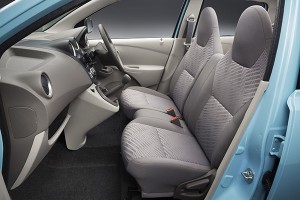 “In absorbing movements, seats play an important role, using innovative technology in frame and springs. This improves the comfort even with a slim design; it also eliminates motion sickness. The fabric pattern and color has been selected to give a feeling of enhanced cabin space with similar color designing of all interiors,” says Ashwani Gupta, programme director, Datsun business unit, Nissan Motor Company.
“In absorbing movements, seats play an important role, using innovative technology in frame and springs. This improves the comfort even with a slim design; it also eliminates motion sickness. The fabric pattern and color has been selected to give a feeling of enhanced cabin space with similar color designing of all interiors,” says Ashwani Gupta, programme director, Datsun business unit, Nissan Motor Company.
Absence of ceiling mounted grab handles inside the cabin on the co-passenger side is the biggest minus point, as there is nothing to hold on to during an emergency. Weighing 796 kg, the car is really light. The team has taken several initiatives to contain weight by managing “body, optimising blanks, balancing suspension, seats, lightweight transmission with gear ratios, engine with some lightweight parts and use of innovative raw materials,” Gupta adds.
 Datsun GO is powered by a 1.2 litre three-cylinder engine. It churns out a maximum power of 68 Ps at 5,000 rpm and a maximum torque of 104 Nm at 4,000 rpm. As per ARAI the car gives a mileage of 20.6 kmpl. The engine thrum is clearly felt due to three-cylinder configuration; “Nissan managed it by carefully designing the balancer shaft, engine mountings and engine control unit,” says Gupta.
Datsun GO is powered by a 1.2 litre three-cylinder engine. It churns out a maximum power of 68 Ps at 5,000 rpm and a maximum torque of 104 Nm at 4,000 rpm. As per ARAI the car gives a mileage of 20.6 kmpl. The engine thrum is clearly felt due to three-cylinder configuration; “Nissan managed it by carefully designing the balancer shaft, engine mountings and engine control unit,” says Gupta.
The electronic accelerator pedal minimises the stroke to ensure smooth driving and it is superior to the cable operated type that needs periodical adjustment. The engine responds well even at higher speeds. Pressed hard to touch 170 kmph (the dial is calibrated only up to 180 kmph) at 4,200 rpm, the vehicle is stable and the steering weighs enough to boost driver confidence. The only negative point is the air-cutting noise inside the cabin, due to inadequate or no sound absorbing cladding.
Steering
Developed by Mando India, Datsun GO’s Electric Power Steering (EPS) system has been tuned by software developed jointly by Nissan Engineering and Mando in Korea. “Notably, we have received ‘Best Engineering Support’ award from Nissan, mainly for the development of this product,” says V Madhavan, joint managing director, Mando India. Software tuning is a code or programme written for the electronic control unit of the EPS that enables adjustment to variable driving speeds. As Indian road conditions demand far more effort to drive, steering has to be well-tuned to handle this. In addition to offering better drivability, the company ended up containing weight by about 12 percent.
Suspension
 Nissan has adopted higher class suspension system with double pivot lower arm for front and torsion beam for the rear. Rear suspension stroke is increased by 30 percent over the industry average, providing a huge gap between the rear wheel arch and the tyre. The quick response damper generates higher damping force in a short time, which instantly keeps the vehicle stable in motion. ‘Infiniti’ technology, confined to luxury brands, is adapted in the GO. The linear and balanced damping force realises smooth and continuous motion for comfortable driving on undulating roads. In the Datsun GO programme, Tenneco’s scope has been limited only to dampers without modular parts. The modular parts for front and rear are held by Nissan.
Nissan has adopted higher class suspension system with double pivot lower arm for front and torsion beam for the rear. Rear suspension stroke is increased by 30 percent over the industry average, providing a huge gap between the rear wheel arch and the tyre. The quick response damper generates higher damping force in a short time, which instantly keeps the vehicle stable in motion. ‘Infiniti’ technology, confined to luxury brands, is adapted in the GO. The linear and balanced damping force realises smooth and continuous motion for comfortable driving on undulating roads. In the Datsun GO programme, Tenneco’s scope has been limited only to dampers without modular parts. The modular parts for front and rear are held by Nissan.
Tenneco used its latest Multi Tunable Valve (MTV) technology for both front strut and rear shock absorbers. Pankaj Kapoor, deputy managing director, Tenneco Automotive India, says, “MTV can be tuned more easily and quickly than contemporary units. Each shock absorber is tuned for a particular platform and apart from differences in dimension and rod size, the tuning is the major variable. Datsun Go was tuned by Tenneco global ride experts, who spent 15 days in test track in different stages of the project and did around 40 iterations to arrive at the required ride quality and handling. Low friction damper was adopted as it offers improvements in steering and ride quality, and increased suspension travel in the rear enhances the ride feel “
Clutch
The responsive nature of the engine, mated with a five-speed gearbox, comes in handy for all traffic conditions due to innovative linkage of the clutch. Exedy’s ‘unity silent design’ clutch is coupled with hydraulic pressure type link, which is otherwise confined to high end cars. The ‘concentric slave cylinder’ clutch release system, supplied by JTEKT, minimises hysteresis (operational resistance), nullifying slack and the subsequent need for adjustment. This special combination simplifies driving on congested roads; the writer experienced this in the small lanes at Golconda Fort in Hyderabad.
 Overall, it is a nice car to drive. “The key point is that we have selected suppliers not only based on commercial cost but on their capability to work with us using the Datsun programme development way of ‘Design to Cost.’ Most of them are global suppliers and we established local specs for relatively high performance through technology and innovation; but the most competitive application is cost control through frugal and pragmatic engineering,” concludes Gupta. (END)
Overall, it is a nice car to drive. “The key point is that we have selected suppliers not only based on commercial cost but on their capability to work with us using the Datsun programme development way of ‘Design to Cost.’ Most of them are global suppliers and we established local specs for relatively high performance through technology and innovation; but the most competitive application is cost control through frugal and pragmatic engineering,” concludes Gupta. (END)





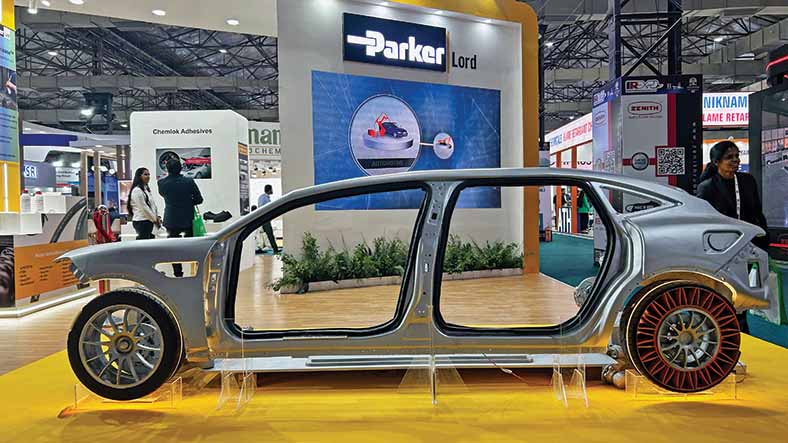
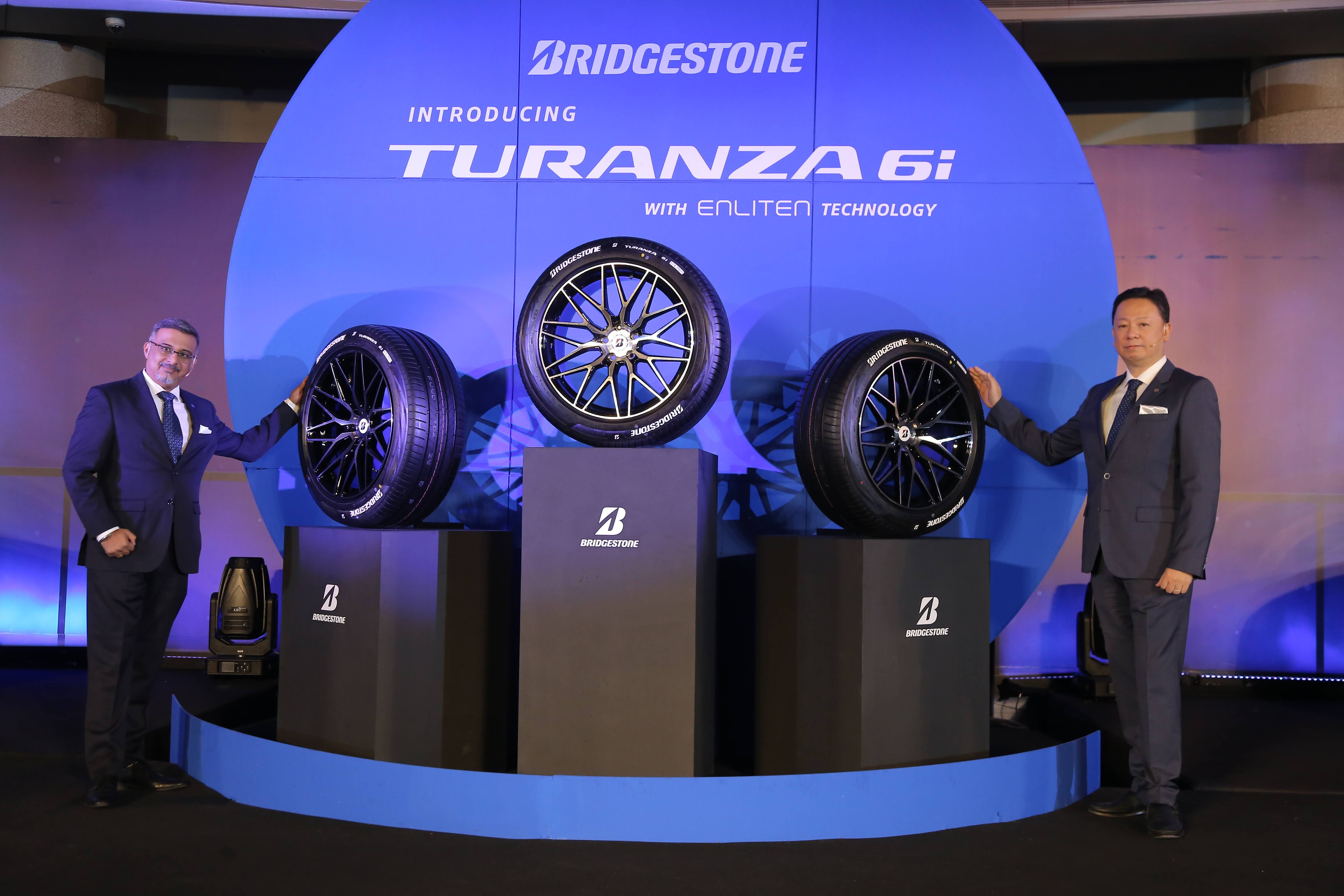
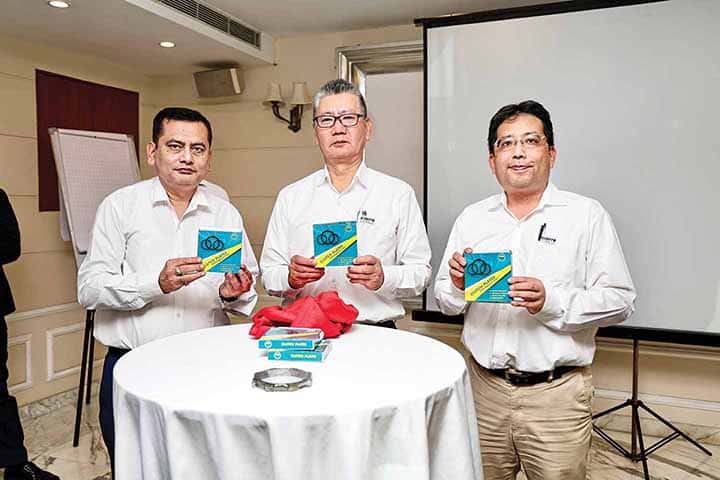

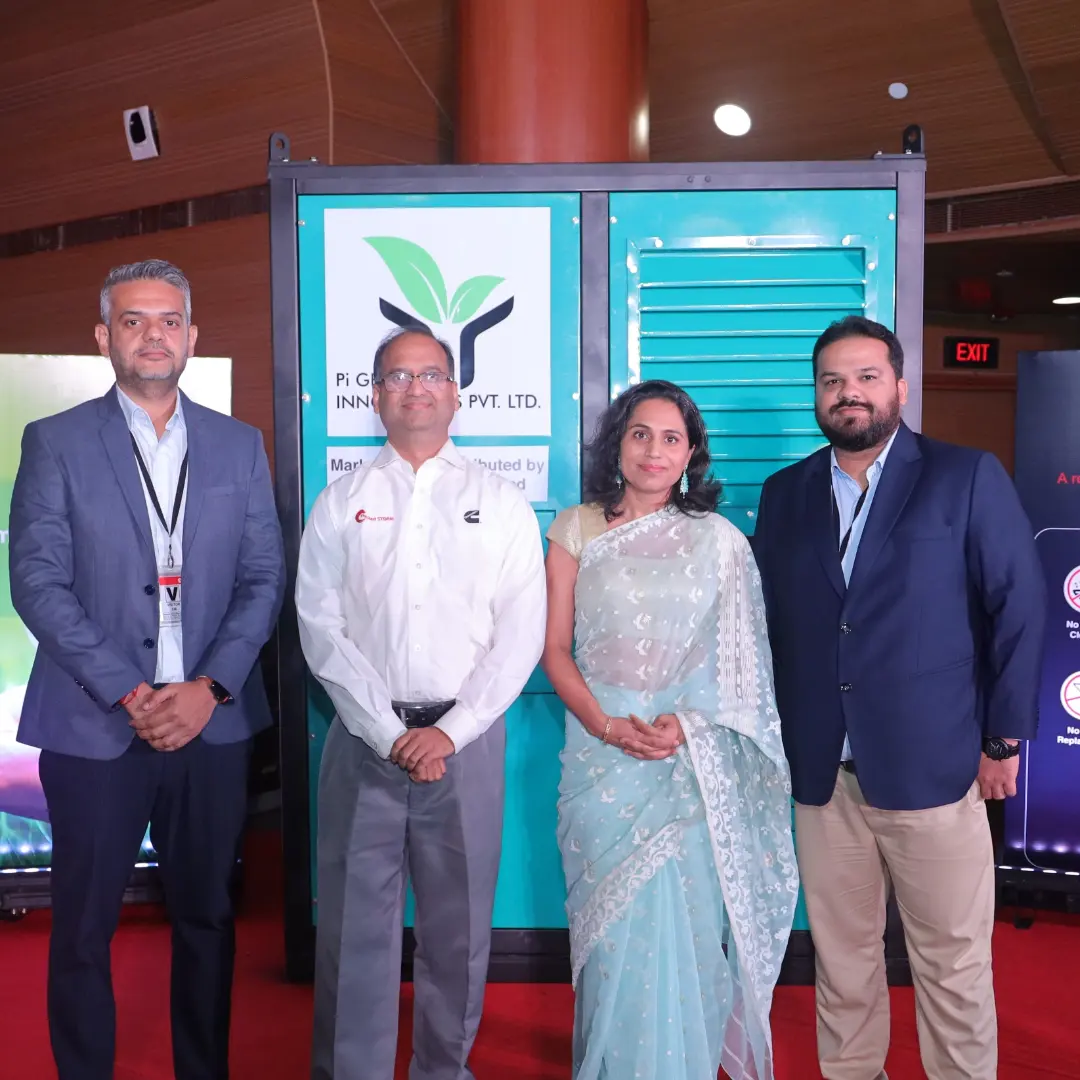



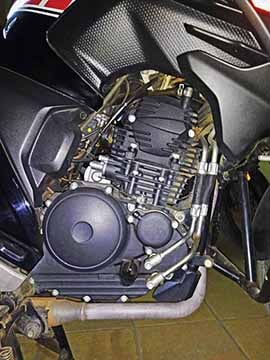


Andrew
If only the car had a aircon, Glove box, bigger tyres (165/80R13) and a 1400cc engine … I’ll place my order A